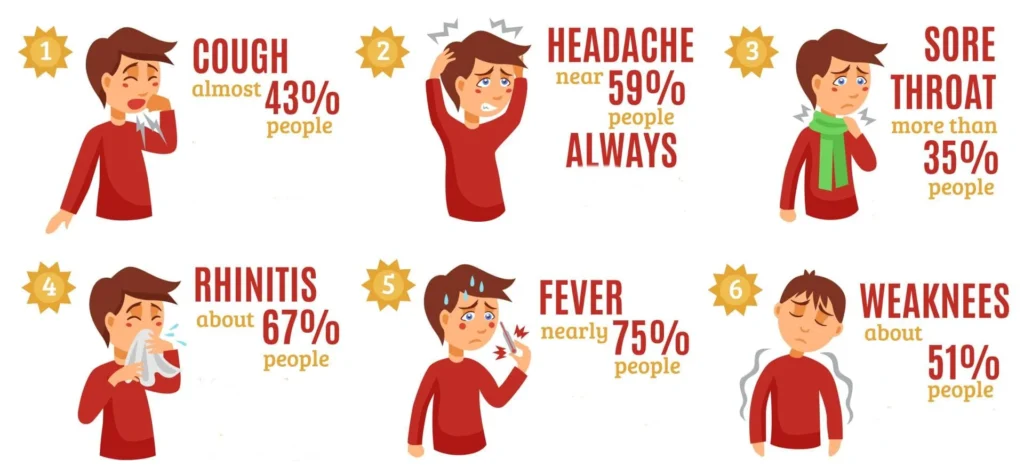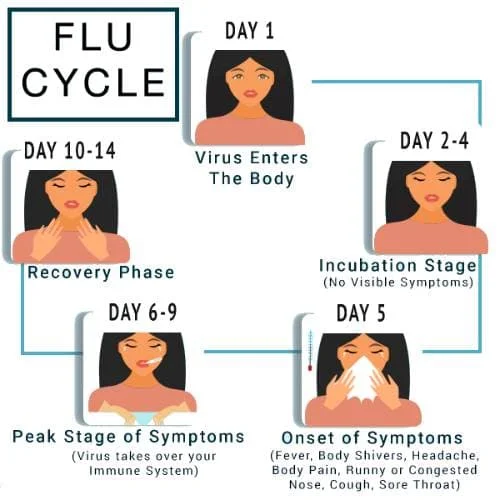Influenza, commonly known as the flu, is a highly contagious respiratory illness that can vary from mild to severe, affecting millions around the world each year. It is much more serious than a typical cold and can cause major health issues, especially in young children, older adults, and individuals with weakened immune systems. This guide offers vital information about the flu, from identifying symptoms and distinguishing between different strains, to understanding the incubation period and exploring effective treatment and prevention strategies. Our goal is to provide you with the knowledge needed to navigate flu season with confidence and care.
What is the Flu?
The flu or influenza, is a contagious respiratory illness caused by viruses that infect the nose, throat and sometimes the lungs. It is more severe than a common cold and tends to develop suddenly. Key symptoms include fever, cough, body aches, and fatigue.
There are two main types of flu viruses that drive seasonal epidemics: Flu A and Flu B.
- Influenza A is generally more severe, can infect both animals and humans, and is more likely to lead to pandemics.
- Influenza B primarily infects humans and usually causes a milder illness, although it can still be serious for vulnerable individuals.
While both types circulate each season, Flu A often dominates. Knowing the difference helps in understanding the outbreak’s severity, but it won’t change how you manage your symptoms.
Recognizing the Signs: Common Flu Symptoms
Understanding the typical signs of influenza can help you tell it apart from other illnesses and know when to seek care. The flu often hits suddenly and can leave you feeling much worse than a simple cold.

Here’s a quick overview of common flu symptoms:
- Fever: Usually high-grade, ranging from 100°F to 104°F (38°C to 40°C) or even higher, especially in children.
- Cough: Typically, dry and persistent, which can become severe and cause chest discomfort.
- Sore Throat: A scratchy or painful feeling in the throat that may make swallowing difficult.
- Muscle Aches: Often intense and felt throughout the body, particularly in the back, arms, and legs.
- Headache: Can vary from mild discomfort to debilitating pain.
- Fatigue: A deep sense of tiredness and weakness that can last for several days or even weeks.
- Chills and Sweats: A feeling of shivering and cold, usually accompanied by sweating.
- Runny or Stuffy Nose: Although more common with a cold, nasal congestion or discharge can also occur with the flu.
Flu vs. Cold vs. COVID-19: Key Symptom Differences
Below is a comparison table that outlines the typical symptoms associated with the flu (influenza), the common cold and COVID-19:
| Symptom | Flu (Influenza) | Common Cold | COVID-19 |
| Fever | Common; often high (100°F+) | Rare | Common; can be high |
| Cough | Common; may be severe | Mild to moderate | Common; often dry |
| Muscle Aches | Common; often severe | Mild | Common; can be severe |
| Fatigue | Common; frequently severe | Mild | Common; can be severe |
| Headache | Common | Sometimes | Common |
| Sore Throat | Common | Common | Sometimes |
| Runny/Stuffy Nose | Sometimes | Common | Sometimes |
| Chills | Common | Uncommon | Common |
| Shortness of Breath | Sometimes, usually with pre-existing conditions | Rare | Common; may be severe |
| Loss of Taste/Smell | Rare | Rare | Common; often a distinguishing feature |
| Nausea/Vomiting | Sometimes (more common in children) | Rare | Sometimes (more common in children) |
| Diarrhea | Sometimes (more common in children) | Rare | Sometimes (more common in children) |
| Onset | Sudden | Gradual | Gradual or sudden |
Important Note:
This table offers general information and should not replace professional medical advice. If you experience any of these symptoms, consult a healthcare provider for a proper diagnosis and treatment. They can also guide you regarding testing for the flu and COVID-19 to ensure you receive the appropriate care.
Does the flu make you throw up?
While less common than other symptoms, the flu can sometimes cause nausea, vomiting, and diarrhea, particularly in children. These symptoms are usually seen with stomach viruses, but they can occur with the flu as well.
How long does fever last with the flu?
The fever that comes with the flu typically lasts for 3 to 5 days, though it can persist for a week or more. It’s important to keep an eye on your temperature and seek medical advice if the fever is very high or does not improve.
Can you have the flu without a fever?
Yes, it is possible to have the flu without a fever, especially among older adults or those with weakened immune systems. While fever is a common sign, its absence does not rule out the flu. Paying attention to other symptoms such as cough, fatigue, and muscle aches is key to recognizing the illness.

Flu Contagion and Incubation Period
Understanding how the flu spreads and the time it takes for symptoms to appear is crucial for preventing its transmission.
Flu Contagious How Long?
People with the flu are typically contagious from about one day before symptoms begin until 5-7 days after falling ill. This means you can pass the virus on even before you realize you’re infected. In some cases, especially in young children and those with weakened immune systems, the contagious period may be longer.
Incubation Period
The flu incubation period is the time between exposure to the virus and the onset of symptoms. For the flu, this period usually lasts 1 to 7 days, with an average of about 2 days. This means that after exposure, you will likely start experiencing symptoms within this timeframe.
How the Flu Spreads
Influenza virus mainly spreads through respiratory droplets produced when an infected person coughs, sneezes, or talks. These droplets can travel up to six feet and may land in the mouths or noses of nearby individuals. Additionally, you can contract the flu by touching a surface contaminated with the virus and then touching your face.
The Flu Stages: Understanding Progression
When you catch the flu, your body goes through a series of stages as it fights off the virus. Knowing what to expect at each stage can make the experience a bit less daunting and help you manage your symptoms more effectively.

1. Incubation Period
After being exposed to the virus, there’s usually a waiting period before you start feeling sick. This is known as the incubation period, which typically lasts 1-4 days. During this time, you might not notice any symptoms, but you can still pass the virus on to others.
2. Acute Stage
This is when the flu hits its hardest. In the acute stage, you might experience:
- High fever
- Chills
- Muscle aches
- Headaches
- A persistent cough
This phase usually lasts 3-5 days, though sometimes it can linger a little longer. It’s also the period when you’re most contagious, so it’s important to rest and avoid contact with others as much as possible.
3. Recovery Stage
As you start to feel better, you’ll enter the recovery stage. Your fever will drop and your energy levels will gradually return. However, you might still have a mild cough or feel a bit tired for another week or two. This slow return to normal is a natural part of the healing process.
Flu Treatment: Managing Symptoms and Seeking Relief
For most people, the flu can be managed at home with proper rest, plenty of fluids, and over-the-counter medications to ease symptoms. However, it’s important to recognize when professional medical advice is needed.

Home Remedies for the Flu Virus
Here are some effective home remedies to help you feel better as your body fights off the infection:
- Rest: Give your body the time it needs to recover by avoiding strenuous activities.
- Fluids: Staying hydrated is essential, especially if you have a fever. Consider these options:
- Warm lemon water with honey: Soothes a sore throat while providing vitamin C.
- Ginger tea: Helps reduce nausea and inflammation—simply steep fresh ginger in hot water.
- Herbal teas: Chamomile, peppermint, or echinacea teas can offer a calming, soothing effect.
- Chicken broth: Provides hydration along with essential electrolytes.
- Pain Relievers: Over the counter medications such as ibuprofen or acetaminophen can reduce fever, muscle aches, and headaches. Always follow the recommended dosage and consult your doctor if you have underlying health conditions or are taking other medications.
Flu Antiviral Medications
Prescription flu antiviral medications, such as oseltamivir (Tamiflu), zanamivir (Relenza), peramivir (Rapivab), and baloxavir marboxil (Xofluza), can help lessen the severity and duration of the flu if taken within the first 48 hours of symptom onset. These drugs work by stopping the virus from multiplying in your body and are particularly recommended for those at high risk of complications, such as young children, older adults, pregnant women, and individuals with chronic medical conditions.
Flu Medicine: Over-the-Counter Options
Beyond pain relievers, several over-the-counter options can assist in managing your symptoms:
- Decongestants: Help relieve nasal congestion.
- Cough Suppressants: Aid in reducing persistent coughing.
- Expectorants: Assist in loosening mucus for easier expulsion.
Important Note: Always read medication labels carefully and follow the instructions, as some products may not be suitable for children or people with certain health issues.
When to See a Doctor
You should seek medical attention if you experience any of the following:
- Difficulty breathing or shortness of breath
- Chest pain or pressure
- Confusion or disorientation
- Severe or persistent vomiting
- Symptoms that initially improve but then return with a fever and worsened cough
- Being part of a high-risk group
Early diagnosis and treatment are key to preventing serious complications.
Flu Prevention: Protecting Yourself and Others
Although there is no guaranteed way to avoid the flu entirely, taking proactive steps can greatly lower your risk of infection and help stop the spread of the virus.

Here are some key strategies for flu prevention:
- Get Vaccinated: The flu vaccine is your best defense against the flu. The CDC recommends that everyone 6 months of age and older receive a flu vaccine each year, making it the most effective preventative measure available.
- Practice Good Hand Hygiene: Regularly wash your hands with soap and water for at least 20 seconds, especially after coughing, sneezing, or spending time in public places. When soap and water aren’t accessible, use an alcohol-based hand sanitizer.
- Avoid Close Contact with Sick Individuals: Try to keep a safe distance from anyone who is sick to minimize your exposure to the virus.
- Cover Your Mouth and Nose: When you cough or sneeze, use a tissue or your elbow rather than your hands. Dispose of tissues immediately to help reduce the spread of respiratory droplets.
- Stay Home When Sick: If you develop flu symptoms, it’s important to stay home from work or school to prevent the virus to others.
- Strengthen Your Immune System: A healthy lifestyle can bolster your body’s defenses. This includes:
- Eating a balanced diet rich in fruits, vegetables, and whole grains.
- Getting sufficient sleep—typically 7 to 9 hours per night for most adults.
- Managing stress through relaxation techniques or exercise.
- Engaging in regular physical activity.
By following these precautions, you can significantly reduce your chances of getting sick and help protect those around you.
The Flu Shot: Your Best Defense
Protecting yourself and those around you from the flu is easier than you might think. Your annual flu shot is a safe, proven method that significantly lowers your risk of illness and helps keep your community healthy.

How It Works?
The flu vaccine works by exposing your body to inactive or weakened forms of the influenza viruses expected to be most common this season. This process prompts your immune system to produce antibodies, which prepare your body to fight off the real virus if you’re exposed. In essence, the flu shot primes your immune system to respond quickly and effectively, reducing the chances of a severe infection.
Who Should Get It?
According to the Centers for Disease Control and Prevention (CDC), everyone 6 months of age and older should receive a flu shot every year. This recommendation is especially important for:
- Young children
- Older adults
- Pregnant women
- Individuals with chronic health conditions
Effectiveness
The effectiveness of the flu vaccine can vary each year, depending on how well the vaccine strains match the circulating viruses. However, even in years when the match isn’t perfect, getting vaccinated can:
- Lessen the severity of your symptoms
- Shorten the duration of your illness
- Reduce your risk of hospitalization and serious complications
Side Effects
Most people experience little to no side effects from the flu shot. Some common, short-lived reactions include:
- Mild soreness, redness, or swelling at the injection site
- A low-grade fever or minor muscle aches
These side effects typically resolve within a day or two, and serious side effects are extremely rare.
Getting your yearly flu shot is a simple yet powerful act of self-care and community responsibility. While no vaccine guarantees complete protection, the benefits of the flu shot far outweigh the risks. Embrace this effective tool to enjoy a healthier, flu-free season.
Flu While Pregnant: Special Considerations
Contracting the flu while pregnant can increase risks for both the mother and the developing baby. Pregnant women are more vulnerable to severe complications such as pneumonia and hospitalization.
The Importance of the Flu Vaccine During Pregnancy
The CDC strongly recommends that pregnant women get the flu vaccine. It is the best way to protect both you and your baby from the flu. The vaccine is safe during any trimester and has been shown to reduce the risk of flu-related complications for both mother and child. Remember, pregnant women should receive the flu shot—not the nasal spray vaccine.
Other Precautions for Pregnant Women
In addition to vaccination, consider these extra steps to lower your risk of getting the flu:
- Practice good hand hygiene.
- Avoid close contact with people who are sick.
- Maintain a healthy diet and ensure you get enough rest.
- Stay well-hydrated.
Medication During Pregnancy
If you develop flu symptoms while pregnant, it’s essential to consult your doctor immediately. Your healthcare provider can advise you on safe treatment options, including whether antiviral medications may be appropriate to lessen the severity and duration of your illness. Do not take any over-the-counter medications without first discussing them with your doctor.
Frequently Asked Questions (FAQs)
How long is the flu contagious?
Typically, people with the flu are contagious starting about one day before symptoms appear and continue to be so for 5-7 days after falling ill. In some cases, especially for young children or those with weakened immune systems—the contagious period may be even longer.
Can the flu be prevented?
While no method offers 100% protection, the annual flu vaccine remains the best way to prevent the flu. In addition to getting vaccinated, other effective preventive measures include frequent handwashing, avoiding close contact with people who are sick, and covering your mouth and nose when you cough or sneeze.
What’s the difference between a cold and the flu?
Both the flu and the common cold affect the respiratory system, but they are caused by different viruses. The flu generally comes suddenly and presents with more severe symptoms such as high fever, body aches, and extreme fatigue, whereas a cold tends to develop more gradually and is usually characterized by a runny or stuffy nose.
Can I get the flu twice in one season?
Yes, it is possible to get the flu more than once in a single season. This can happen if you are exposed to different strains of the flu virus, as immunity from one strain does not necessarily protect against another.
What should I eat when I have the flu?
When you’re battling the flu, staying hydrated is key. Drinking plenty of fluids such as water, clear broth, or herbal tea can help. It’s also a good idea to eat light, easily digestible foods—like toast, crackers, or rice—which can help keep your energy up without overwhelming your stomach.






